Brand Management Report: Apple Inc. Branding, Strategies, and Analysis
VerifiedAdded on 2021/02/18
|17
|5513
|35
Report
AI Summary
This report provides a comprehensive analysis of brand management, using Apple Inc. as a case study. It begins with an introduction to brand management, explaining its importance as a marketing tool and its evolution in business practice. The report then explores the key components of a successful brand strategy, including brand awareness, association, perceived quality, loyalty, and proprietary brand assets. It delves into various branding models and theories, such as Keller's Brand Equity Model and the Theory of Branding Design, to understand how brands are successfully managed. The report also examines different portfolio management strategies, including active and passive approaches, and analyzes Apple Inc.'s brand hierarchy and brand equity management strategies. Furthermore, it discusses managing brands at domestic and global levels, and explores techniques for measuring and managing brand value. The report concludes with a summary of the key findings and insights into building a strong and enduring brand.

BRAND
MANAGEMENT
MANAGEMENT
Paraphrase This Document
Need a fresh take? Get an instant paraphrase of this document with our AI Paraphraser
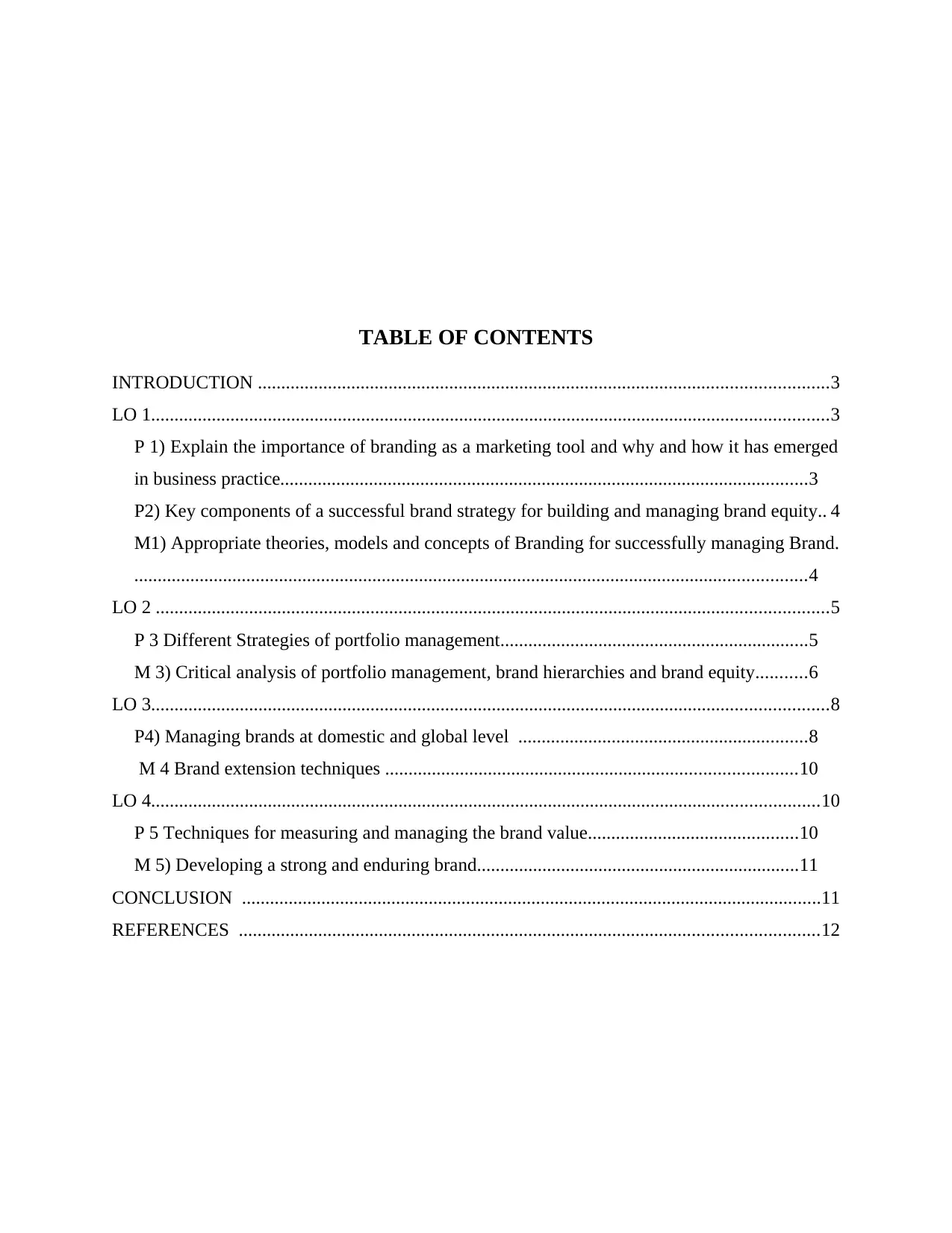
TABLE OF CONTENTS
INTRODUCTION ..........................................................................................................................3
LO 1.................................................................................................................................................3
P 1) Explain the importance of branding as a marketing tool and why and how it has emerged
in business practice.................................................................................................................3
P2) Key components of a successful brand strategy for building and managing brand equity.. 4
M1) Appropriate theories, models and concepts of Branding for successfully managing Brand.
................................................................................................................................................4
LO 2 ................................................................................................................................................5
P 3 Different Strategies of portfolio management..................................................................5
M 3) Critical analysis of portfolio management, brand hierarchies and brand equity...........6
LO 3.................................................................................................................................................8
P4) Managing brands at domestic and global level ..............................................................8
M 4 Brand extension techniques ........................................................................................10
LO 4...............................................................................................................................................10
P 5 Techniques for measuring and managing the brand value.............................................10
M 5) Developing a strong and enduring brand.....................................................................11
CONCLUSION ............................................................................................................................11
REFERENCES ............................................................................................................................12
INTRODUCTION ..........................................................................................................................3
LO 1.................................................................................................................................................3
P 1) Explain the importance of branding as a marketing tool and why and how it has emerged
in business practice.................................................................................................................3
P2) Key components of a successful brand strategy for building and managing brand equity.. 4
M1) Appropriate theories, models and concepts of Branding for successfully managing Brand.
................................................................................................................................................4
LO 2 ................................................................................................................................................5
P 3 Different Strategies of portfolio management..................................................................5
M 3) Critical analysis of portfolio management, brand hierarchies and brand equity...........6
LO 3.................................................................................................................................................8
P4) Managing brands at domestic and global level ..............................................................8
M 4 Brand extension techniques ........................................................................................10
LO 4...............................................................................................................................................10
P 5 Techniques for measuring and managing the brand value.............................................10
M 5) Developing a strong and enduring brand.....................................................................11
CONCLUSION ............................................................................................................................11
REFERENCES ............................................................................................................................12
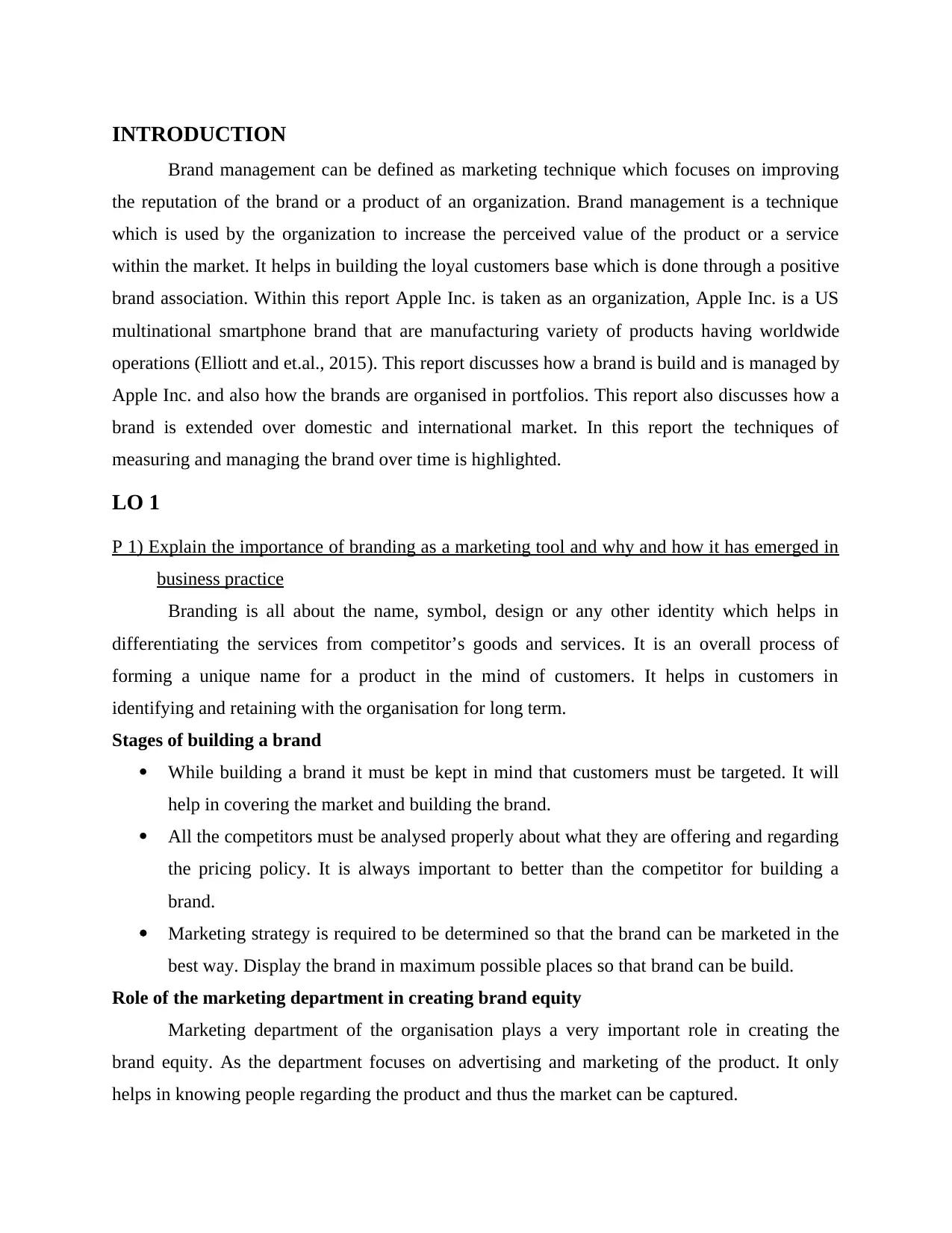
INTRODUCTION
Brand management can be defined as marketing technique which focuses on improving
the reputation of the brand or a product of an organization. Brand management is a technique
which is used by the organization to increase the perceived value of the product or a service
within the market. It helps in building the loyal customers base which is done through a positive
brand association. Within this report Apple Inc. is taken as an organization, Apple Inc. is a US
multinational smartphone brand that are manufacturing variety of products having worldwide
operations (Elliott and et.al., 2015). This report discusses how a brand is build and is managed by
Apple Inc. and also how the brands are organised in portfolios. This report also discusses how a
brand is extended over domestic and international market. In this report the techniques of
measuring and managing the brand over time is highlighted.
LO 1
P 1) Explain the importance of branding as a marketing tool and why and how it has emerged in
business practice
Branding is all about the name, symbol, design or any other identity which helps in
differentiating the services from competitor’s goods and services. It is an overall process of
forming a unique name for a product in the mind of customers. It helps in customers in
identifying and retaining with the organisation for long term.
Stages of building a brand
While building a brand it must be kept in mind that customers must be targeted. It will
help in covering the market and building the brand.
All the competitors must be analysed properly about what they are offering and regarding
the pricing policy. It is always important to better than the competitor for building a
brand.
Marketing strategy is required to be determined so that the brand can be marketed in the
best way. Display the brand in maximum possible places so that brand can be build.
Role of the marketing department in creating brand equity
Marketing department of the organisation plays a very important role in creating the
brand equity. As the department focuses on advertising and marketing of the product. It only
helps in knowing people regarding the product and thus the market can be captured.
Brand management can be defined as marketing technique which focuses on improving
the reputation of the brand or a product of an organization. Brand management is a technique
which is used by the organization to increase the perceived value of the product or a service
within the market. It helps in building the loyal customers base which is done through a positive
brand association. Within this report Apple Inc. is taken as an organization, Apple Inc. is a US
multinational smartphone brand that are manufacturing variety of products having worldwide
operations (Elliott and et.al., 2015). This report discusses how a brand is build and is managed by
Apple Inc. and also how the brands are organised in portfolios. This report also discusses how a
brand is extended over domestic and international market. In this report the techniques of
measuring and managing the brand over time is highlighted.
LO 1
P 1) Explain the importance of branding as a marketing tool and why and how it has emerged in
business practice
Branding is all about the name, symbol, design or any other identity which helps in
differentiating the services from competitor’s goods and services. It is an overall process of
forming a unique name for a product in the mind of customers. It helps in customers in
identifying and retaining with the organisation for long term.
Stages of building a brand
While building a brand it must be kept in mind that customers must be targeted. It will
help in covering the market and building the brand.
All the competitors must be analysed properly about what they are offering and regarding
the pricing policy. It is always important to better than the competitor for building a
brand.
Marketing strategy is required to be determined so that the brand can be marketed in the
best way. Display the brand in maximum possible places so that brand can be build.
Role of the marketing department in creating brand equity
Marketing department of the organisation plays a very important role in creating the
brand equity. As the department focuses on advertising and marketing of the product. It only
helps in knowing people regarding the product and thus the market can be captured.
⊘ This is a preview!⊘
Do you want full access?
Subscribe today to unlock all pages.

Trusted by 1+ million students worldwide
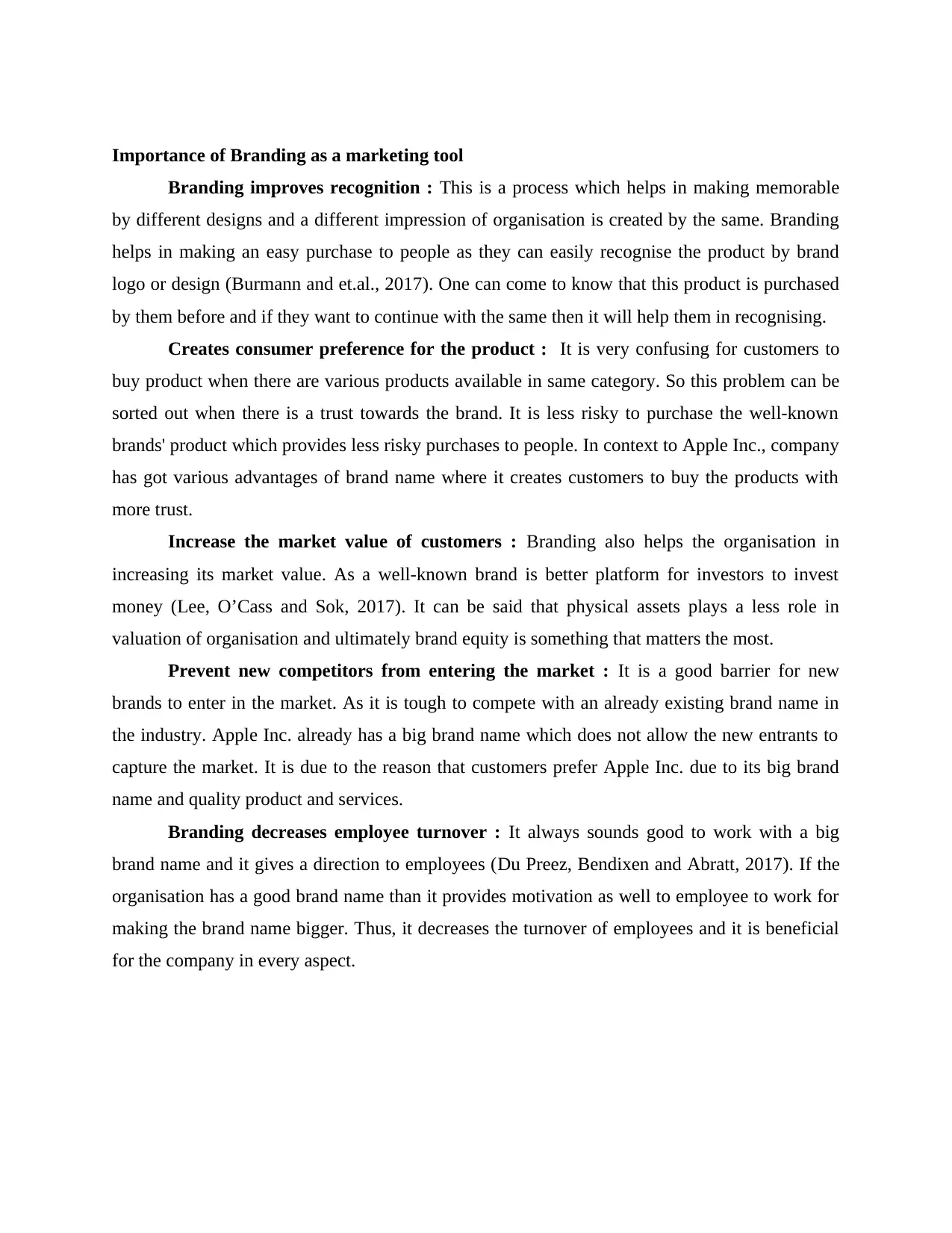
Importance of Branding as a marketing tool
Branding improves recognition : This is a process which helps in making memorable
by different designs and a different impression of organisation is created by the same. Branding
helps in making an easy purchase to people as they can easily recognise the product by brand
logo or design (Burmann and et.al., 2017). One can come to know that this product is purchased
by them before and if they want to continue with the same then it will help them in recognising.
Creates consumer preference for the product : It is very confusing for customers to
buy product when there are various products available in same category. So this problem can be
sorted out when there is a trust towards the brand. It is less risky to purchase the well-known
brands' product which provides less risky purchases to people. In context to Apple Inc., company
has got various advantages of brand name where it creates customers to buy the products with
more trust.
Increase the market value of customers : Branding also helps the organisation in
increasing its market value. As a well-known brand is better platform for investors to invest
money (Lee, O’Cass and Sok, 2017). It can be said that physical assets plays a less role in
valuation of organisation and ultimately brand equity is something that matters the most.
Prevent new competitors from entering the market : It is a good barrier for new
brands to enter in the market. As it is tough to compete with an already existing brand name in
the industry. Apple Inc. already has a big brand name which does not allow the new entrants to
capture the market. It is due to the reason that customers prefer Apple Inc. due to its big brand
name and quality product and services.
Branding decreases employee turnover : It always sounds good to work with a big
brand name and it gives a direction to employees (Du Preez, Bendixen and Abratt, 2017). If the
organisation has a good brand name than it provides motivation as well to employee to work for
making the brand name bigger. Thus, it decreases the turnover of employees and it is beneficial
for the company in every aspect.
Branding improves recognition : This is a process which helps in making memorable
by different designs and a different impression of organisation is created by the same. Branding
helps in making an easy purchase to people as they can easily recognise the product by brand
logo or design (Burmann and et.al., 2017). One can come to know that this product is purchased
by them before and if they want to continue with the same then it will help them in recognising.
Creates consumer preference for the product : It is very confusing for customers to
buy product when there are various products available in same category. So this problem can be
sorted out when there is a trust towards the brand. It is less risky to purchase the well-known
brands' product which provides less risky purchases to people. In context to Apple Inc., company
has got various advantages of brand name where it creates customers to buy the products with
more trust.
Increase the market value of customers : Branding also helps the organisation in
increasing its market value. As a well-known brand is better platform for investors to invest
money (Lee, O’Cass and Sok, 2017). It can be said that physical assets plays a less role in
valuation of organisation and ultimately brand equity is something that matters the most.
Prevent new competitors from entering the market : It is a good barrier for new
brands to enter in the market. As it is tough to compete with an already existing brand name in
the industry. Apple Inc. already has a big brand name which does not allow the new entrants to
capture the market. It is due to the reason that customers prefer Apple Inc. due to its big brand
name and quality product and services.
Branding decreases employee turnover : It always sounds good to work with a big
brand name and it gives a direction to employees (Du Preez, Bendixen and Abratt, 2017). If the
organisation has a good brand name than it provides motivation as well to employee to work for
making the brand name bigger. Thus, it decreases the turnover of employees and it is beneficial
for the company in every aspect.
Paraphrase This Document
Need a fresh take? Get an instant paraphrase of this document with our AI Paraphraser
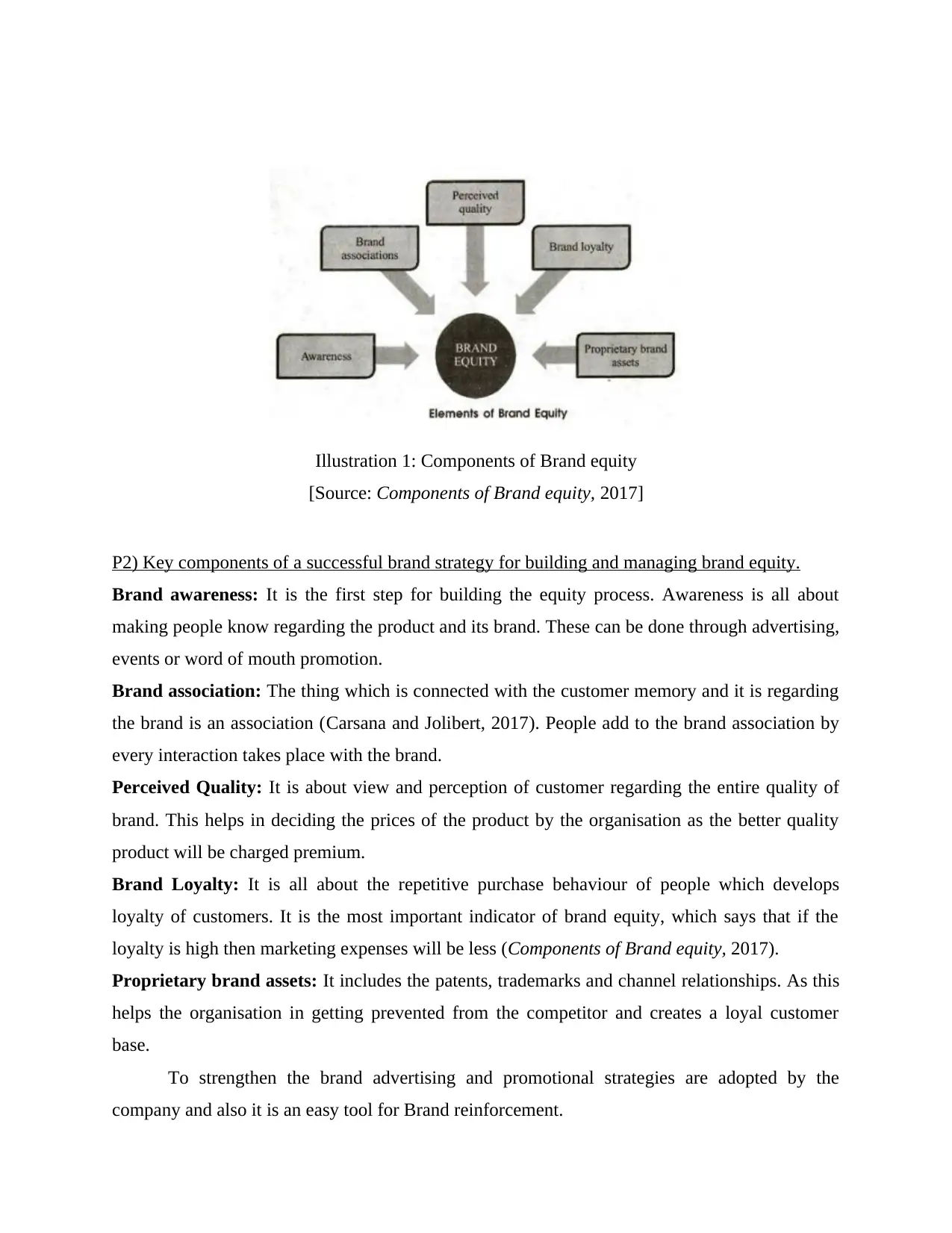
P2) Key components of a successful brand strategy for building and managing brand equity.
Brand awareness: It is the first step for building the equity process. Awareness is all about
making people know regarding the product and its brand. These can be done through advertising,
events or word of mouth promotion.
Brand association: The thing which is connected with the customer memory and it is regarding
the brand is an association (Carsana and Jolibert, 2017). People add to the brand association by
every interaction takes place with the brand.
Perceived Quality: It is about view and perception of customer regarding the entire quality of
brand. This helps in deciding the prices of the product by the organisation as the better quality
product will be charged premium.
Brand Loyalty: It is all about the repetitive purchase behaviour of people which develops
loyalty of customers. It is the most important indicator of brand equity, which says that if the
loyalty is high then marketing expenses will be less (Components of Brand equity, 2017).
Proprietary brand assets: It includes the patents, trademarks and channel relationships. As this
helps the organisation in getting prevented from the competitor and creates a loyal customer
base.
To strengthen the brand advertising and promotional strategies are adopted by the
company and also it is an easy tool for Brand reinforcement.
Illustration 1: Components of Brand equity
[Source: Components of Brand equity, 2017]
Brand awareness: It is the first step for building the equity process. Awareness is all about
making people know regarding the product and its brand. These can be done through advertising,
events or word of mouth promotion.
Brand association: The thing which is connected with the customer memory and it is regarding
the brand is an association (Carsana and Jolibert, 2017). People add to the brand association by
every interaction takes place with the brand.
Perceived Quality: It is about view and perception of customer regarding the entire quality of
brand. This helps in deciding the prices of the product by the organisation as the better quality
product will be charged premium.
Brand Loyalty: It is all about the repetitive purchase behaviour of people which develops
loyalty of customers. It is the most important indicator of brand equity, which says that if the
loyalty is high then marketing expenses will be less (Components of Brand equity, 2017).
Proprietary brand assets: It includes the patents, trademarks and channel relationships. As this
helps the organisation in getting prevented from the competitor and creates a loyal customer
base.
To strengthen the brand advertising and promotional strategies are adopted by the
company and also it is an easy tool for Brand reinforcement.
Illustration 1: Components of Brand equity
[Source: Components of Brand equity, 2017]
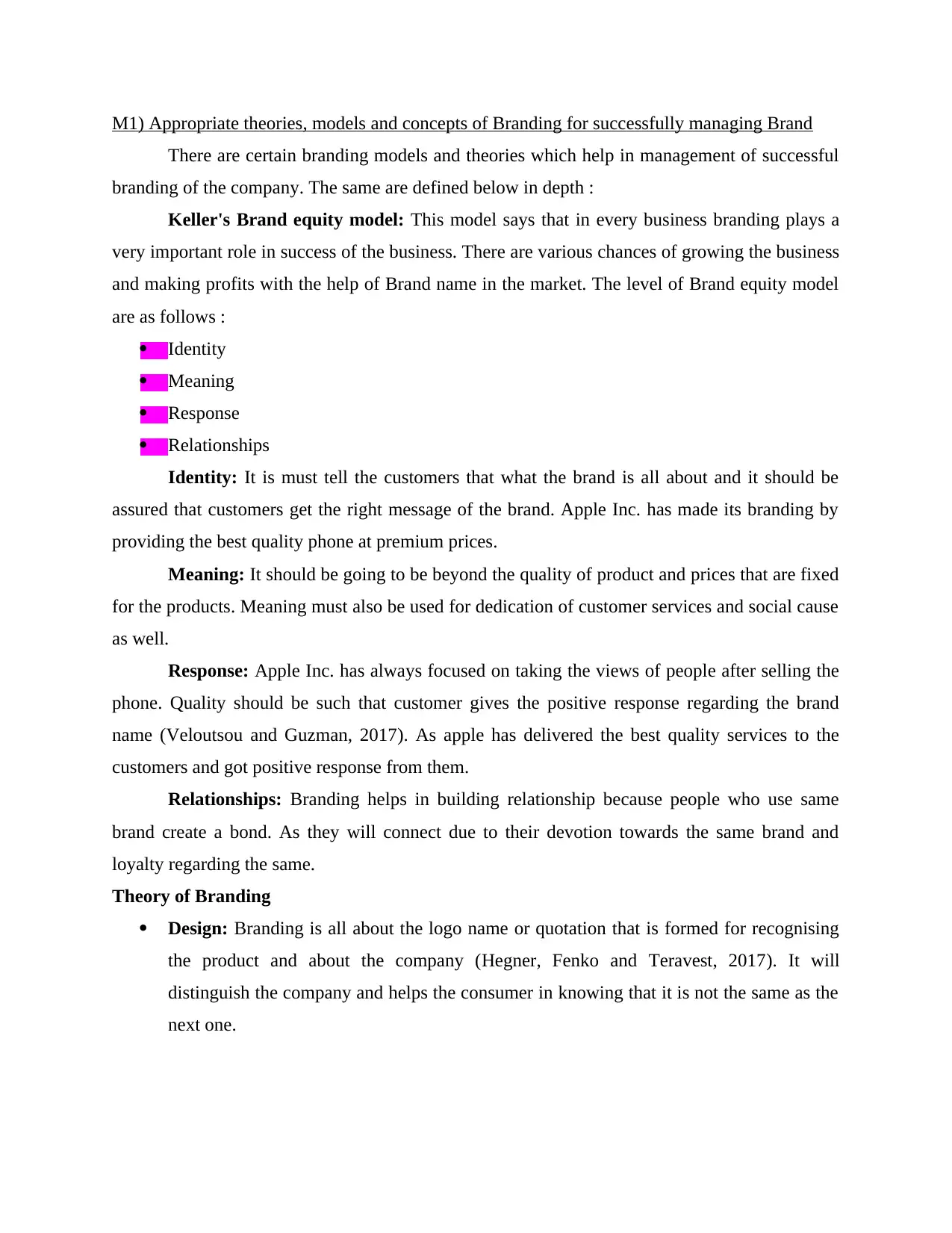
M1) Appropriate theories, models and concepts of Branding for successfully managing Brand
There are certain branding models and theories which help in management of successful
branding of the company. The same are defined below in depth :
Keller's Brand equity model: This model says that in every business branding plays a
very important role in success of the business. There are various chances of growing the business
and making profits with the help of Brand name in the market. The level of Brand equity model
are as follows :
Identity
Meaning
Response
Relationships
Identity: It is must tell the customers that what the brand is all about and it should be
assured that customers get the right message of the brand. Apple Inc. has made its branding by
providing the best quality phone at premium prices.
Meaning: It should be going to be beyond the quality of product and prices that are fixed
for the products. Meaning must also be used for dedication of customer services and social cause
as well.
Response: Apple Inc. has always focused on taking the views of people after selling the
phone. Quality should be such that customer gives the positive response regarding the brand
name (Veloutsou and Guzman, 2017). As apple has delivered the best quality services to the
customers and got positive response from them.
Relationships: Branding helps in building relationship because people who use same
brand create a bond. As they will connect due to their devotion towards the same brand and
loyalty regarding the same.
Theory of Branding
Design: Branding is all about the logo name or quotation that is formed for recognising
the product and about the company (Hegner, Fenko and Teravest, 2017). It will
distinguish the company and helps the consumer in knowing that it is not the same as the
next one.
There are certain branding models and theories which help in management of successful
branding of the company. The same are defined below in depth :
Keller's Brand equity model: This model says that in every business branding plays a
very important role in success of the business. There are various chances of growing the business
and making profits with the help of Brand name in the market. The level of Brand equity model
are as follows :
Identity
Meaning
Response
Relationships
Identity: It is must tell the customers that what the brand is all about and it should be
assured that customers get the right message of the brand. Apple Inc. has made its branding by
providing the best quality phone at premium prices.
Meaning: It should be going to be beyond the quality of product and prices that are fixed
for the products. Meaning must also be used for dedication of customer services and social cause
as well.
Response: Apple Inc. has always focused on taking the views of people after selling the
phone. Quality should be such that customer gives the positive response regarding the brand
name (Veloutsou and Guzman, 2017). As apple has delivered the best quality services to the
customers and got positive response from them.
Relationships: Branding helps in building relationship because people who use same
brand create a bond. As they will connect due to their devotion towards the same brand and
loyalty regarding the same.
Theory of Branding
Design: Branding is all about the logo name or quotation that is formed for recognising
the product and about the company (Hegner, Fenko and Teravest, 2017). It will
distinguish the company and helps the consumer in knowing that it is not the same as the
next one.
⊘ This is a preview!⊘
Do you want full access?
Subscribe today to unlock all pages.

Trusted by 1+ million students worldwide
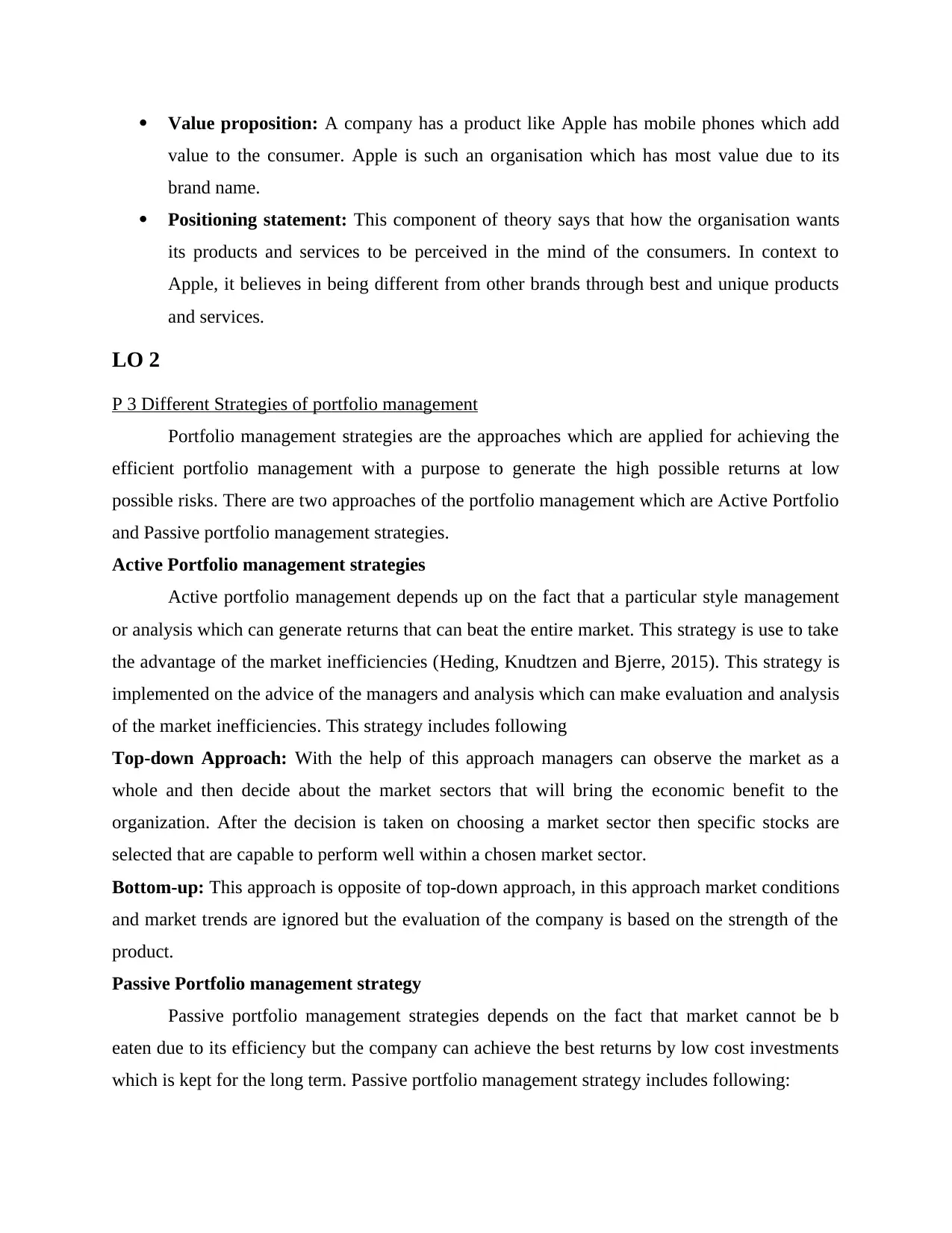
Value proposition: A company has a product like Apple has mobile phones which add
value to the consumer. Apple is such an organisation which has most value due to its
brand name.
Positioning statement: This component of theory says that how the organisation wants
its products and services to be perceived in the mind of the consumers. In context to
Apple, it believes in being different from other brands through best and unique products
and services.
LO 2
P 3 Different Strategies of portfolio management
Portfolio management strategies are the approaches which are applied for achieving the
efficient portfolio management with a purpose to generate the high possible returns at low
possible risks. There are two approaches of the portfolio management which are Active Portfolio
and Passive portfolio management strategies.
Active Portfolio management strategies
Active portfolio management depends up on the fact that a particular style management
or analysis which can generate returns that can beat the entire market. This strategy is use to take
the advantage of the market inefficiencies (Heding, Knudtzen and Bjerre, 2015). This strategy is
implemented on the advice of the managers and analysis which can make evaluation and analysis
of the market inefficiencies. This strategy includes following
Top-down Approach: With the help of this approach managers can observe the market as a
whole and then decide about the market sectors that will bring the economic benefit to the
organization. After the decision is taken on choosing a market sector then specific stocks are
selected that are capable to perform well within a chosen market sector.
Bottom-up: This approach is opposite of top-down approach, in this approach market conditions
and market trends are ignored but the evaluation of the company is based on the strength of the
product.
Passive Portfolio management strategy
Passive portfolio management strategies depends on the fact that market cannot be b
eaten due to its efficiency but the company can achieve the best returns by low cost investments
which is kept for the long term. Passive portfolio management strategy includes following:
value to the consumer. Apple is such an organisation which has most value due to its
brand name.
Positioning statement: This component of theory says that how the organisation wants
its products and services to be perceived in the mind of the consumers. In context to
Apple, it believes in being different from other brands through best and unique products
and services.
LO 2
P 3 Different Strategies of portfolio management
Portfolio management strategies are the approaches which are applied for achieving the
efficient portfolio management with a purpose to generate the high possible returns at low
possible risks. There are two approaches of the portfolio management which are Active Portfolio
and Passive portfolio management strategies.
Active Portfolio management strategies
Active portfolio management depends up on the fact that a particular style management
or analysis which can generate returns that can beat the entire market. This strategy is use to take
the advantage of the market inefficiencies (Heding, Knudtzen and Bjerre, 2015). This strategy is
implemented on the advice of the managers and analysis which can make evaluation and analysis
of the market inefficiencies. This strategy includes following
Top-down Approach: With the help of this approach managers can observe the market as a
whole and then decide about the market sectors that will bring the economic benefit to the
organization. After the decision is taken on choosing a market sector then specific stocks are
selected that are capable to perform well within a chosen market sector.
Bottom-up: This approach is opposite of top-down approach, in this approach market conditions
and market trends are ignored but the evaluation of the company is based on the strength of the
product.
Passive Portfolio management strategy
Passive portfolio management strategies depends on the fact that market cannot be b
eaten due to its efficiency but the company can achieve the best returns by low cost investments
which is kept for the long term. Passive portfolio management strategy includes following:
Paraphrase This Document
Need a fresh take? Get an instant paraphrase of this document with our AI Paraphraser
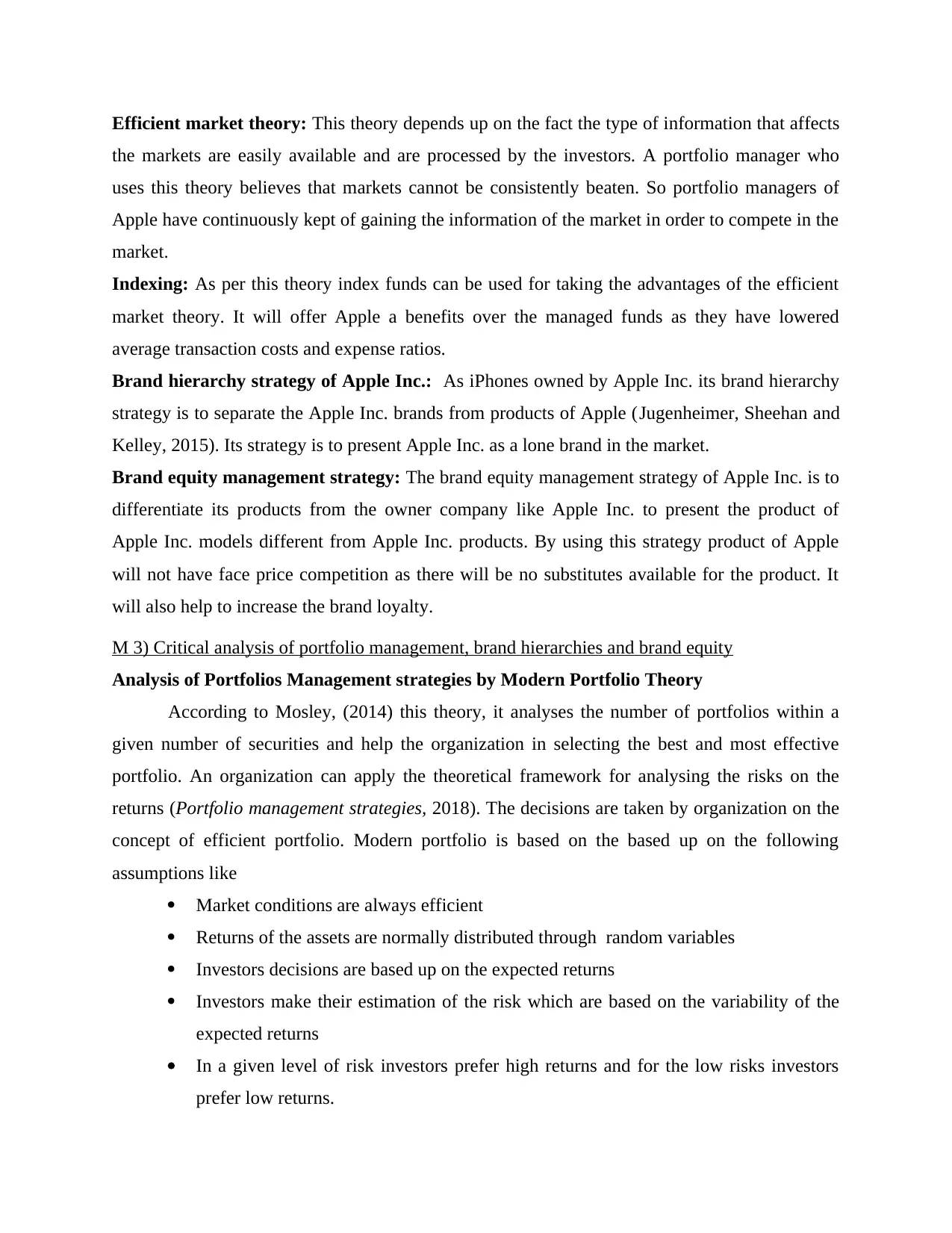
Efficient market theory: This theory depends up on the fact the type of information that affects
the markets are easily available and are processed by the investors. A portfolio manager who
uses this theory believes that markets cannot be consistently beaten. So portfolio managers of
Apple have continuously kept of gaining the information of the market in order to compete in the
market.
Indexing: As per this theory index funds can be used for taking the advantages of the efficient
market theory. It will offer Apple a benefits over the managed funds as they have lowered
average transaction costs and expense ratios.
Brand hierarchy strategy of Apple Inc.: As iPhones owned by Apple Inc. its brand hierarchy
strategy is to separate the Apple Inc. brands from products of Apple (Jugenheimer, Sheehan and
Kelley, 2015). Its strategy is to present Apple Inc. as a lone brand in the market.
Brand equity management strategy: The brand equity management strategy of Apple Inc. is to
differentiate its products from the owner company like Apple Inc. to present the product of
Apple Inc. models different from Apple Inc. products. By using this strategy product of Apple
will not have face price competition as there will be no substitutes available for the product. It
will also help to increase the brand loyalty.
M 3) Critical analysis of portfolio management, brand hierarchies and brand equity
Analysis of Portfolios Management strategies by Modern Portfolio Theory
According to Mosley, (2014) this theory, it analyses the number of portfolios within a
given number of securities and help the organization in selecting the best and most effective
portfolio. An organization can apply the theoretical framework for analysing the risks on the
returns (Portfolio management strategies, 2018). The decisions are taken by organization on the
concept of efficient portfolio. Modern portfolio is based on the based up on the following
assumptions like
Market conditions are always efficient
Returns of the assets are normally distributed through random variables
Investors decisions are based up on the expected returns
Investors make their estimation of the risk which are based on the variability of the
expected returns
In a given level of risk investors prefer high returns and for the low risks investors
prefer low returns.
the markets are easily available and are processed by the investors. A portfolio manager who
uses this theory believes that markets cannot be consistently beaten. So portfolio managers of
Apple have continuously kept of gaining the information of the market in order to compete in the
market.
Indexing: As per this theory index funds can be used for taking the advantages of the efficient
market theory. It will offer Apple a benefits over the managed funds as they have lowered
average transaction costs and expense ratios.
Brand hierarchy strategy of Apple Inc.: As iPhones owned by Apple Inc. its brand hierarchy
strategy is to separate the Apple Inc. brands from products of Apple (Jugenheimer, Sheehan and
Kelley, 2015). Its strategy is to present Apple Inc. as a lone brand in the market.
Brand equity management strategy: The brand equity management strategy of Apple Inc. is to
differentiate its products from the owner company like Apple Inc. to present the product of
Apple Inc. models different from Apple Inc. products. By using this strategy product of Apple
will not have face price competition as there will be no substitutes available for the product. It
will also help to increase the brand loyalty.
M 3) Critical analysis of portfolio management, brand hierarchies and brand equity
Analysis of Portfolios Management strategies by Modern Portfolio Theory
According to Mosley, (2014) this theory, it analyses the number of portfolios within a
given number of securities and help the organization in selecting the best and most effective
portfolio. An organization can apply the theoretical framework for analysing the risks on the
returns (Portfolio management strategies, 2018). The decisions are taken by organization on the
concept of efficient portfolio. Modern portfolio is based on the based up on the following
assumptions like
Market conditions are always efficient
Returns of the assets are normally distributed through random variables
Investors decisions are based up on the expected returns
Investors make their estimation of the risk which are based on the variability of the
expected returns
In a given level of risk investors prefer high returns and for the low risks investors
prefer low returns.
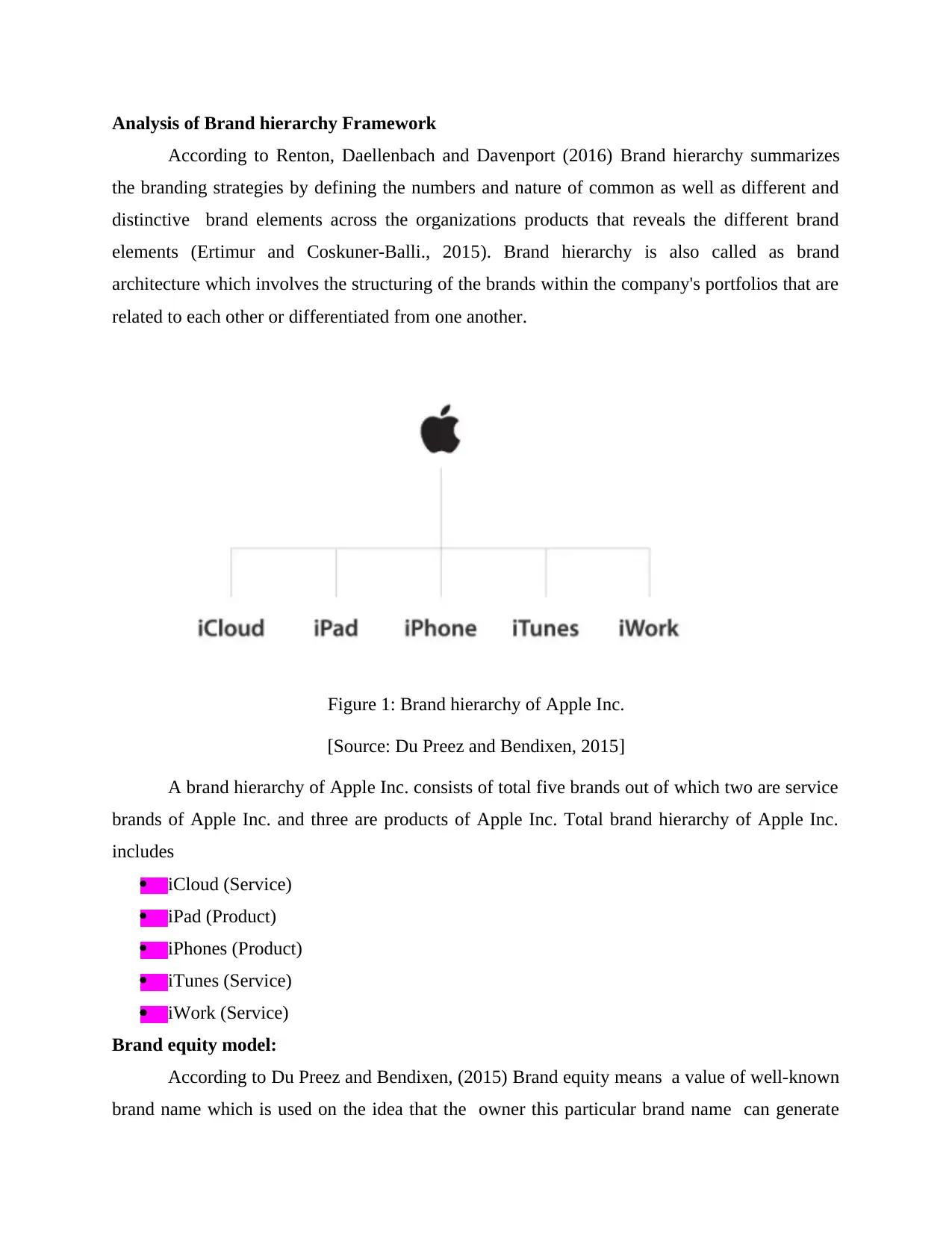
Analysis of Brand hierarchy Framework
According to Renton, Daellenbach and Davenport (2016) Brand hierarchy summarizes
the branding strategies by defining the numbers and nature of common as well as different and
distinctive brand elements across the organizations products that reveals the different brand
elements (Ertimur and Coskuner-Balli., 2015). Brand hierarchy is also called as brand
architecture which involves the structuring of the brands within the company's portfolios that are
related to each other or differentiated from one another.
Figure 1: Brand hierarchy of Apple Inc.
[Source: Du Preez and Bendixen, 2015]
A brand hierarchy of Apple Inc. consists of total five brands out of which two are service
brands of Apple Inc. and three are products of Apple Inc. Total brand hierarchy of Apple Inc.
includes
iCloud (Service)
iPad (Product)
iPhones (Product)
iTunes (Service)
iWork (Service)
Brand equity model:
According to Du Preez and Bendixen, (2015) Brand equity means a value of well-known
brand name which is used on the idea that the owner this particular brand name can generate
According to Renton, Daellenbach and Davenport (2016) Brand hierarchy summarizes
the branding strategies by defining the numbers and nature of common as well as different and
distinctive brand elements across the organizations products that reveals the different brand
elements (Ertimur and Coskuner-Balli., 2015). Brand hierarchy is also called as brand
architecture which involves the structuring of the brands within the company's portfolios that are
related to each other or differentiated from one another.
Figure 1: Brand hierarchy of Apple Inc.
[Source: Du Preez and Bendixen, 2015]
A brand hierarchy of Apple Inc. consists of total five brands out of which two are service
brands of Apple Inc. and three are products of Apple Inc. Total brand hierarchy of Apple Inc.
includes
iCloud (Service)
iPad (Product)
iPhones (Product)
iTunes (Service)
iWork (Service)
Brand equity model:
According to Du Preez and Bendixen, (2015) Brand equity means a value of well-known
brand name which is used on the idea that the owner this particular brand name can generate
⊘ This is a preview!⊘
Do you want full access?
Subscribe today to unlock all pages.

Trusted by 1+ million students worldwide
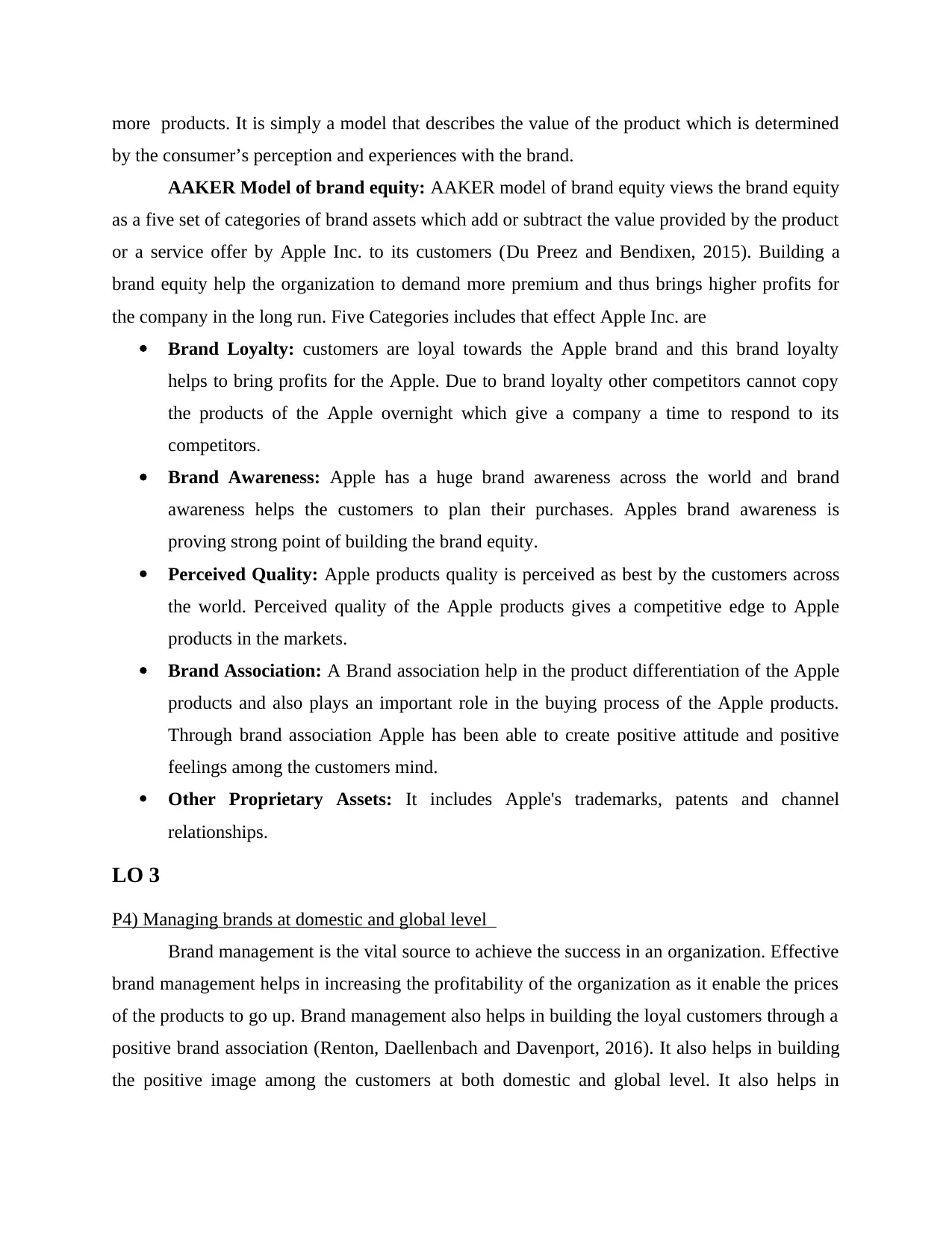
more products. It is simply a model that describes the value of the product which is determined
by the consumer’s perception and experiences with the brand.
AAKER Model of brand equity: AAKER model of brand equity views the brand equity
as a five set of categories of brand assets which add or subtract the value provided by the product
or a service offer by Apple Inc. to its customers (Du Preez and Bendixen, 2015). Building a
brand equity help the organization to demand more premium and thus brings higher profits for
the company in the long run. Five Categories includes that effect Apple Inc. are
Brand Loyalty: customers are loyal towards the Apple brand and this brand loyalty
helps to bring profits for the Apple. Due to brand loyalty other competitors cannot copy
the products of the Apple overnight which give a company a time to respond to its
competitors.
Brand Awareness: Apple has a huge brand awareness across the world and brand
awareness helps the customers to plan their purchases. Apples brand awareness is
proving strong point of building the brand equity.
Perceived Quality: Apple products quality is perceived as best by the customers across
the world. Perceived quality of the Apple products gives a competitive edge to Apple
products in the markets.
Brand Association: A Brand association help in the product differentiation of the Apple
products and also plays an important role in the buying process of the Apple products.
Through brand association Apple has been able to create positive attitude and positive
feelings among the customers mind.
Other Proprietary Assets: It includes Apple's trademarks, patents and channel
relationships.
LO 3
P4) Managing brands at domestic and global level
Brand management is the vital source to achieve the success in an organization. Effective
brand management helps in increasing the profitability of the organization as it enable the prices
of the products to go up. Brand management also helps in building the loyal customers through a
positive brand association (Renton, Daellenbach and Davenport, 2016). It also helps in building
the positive image among the customers at both domestic and global level. It also helps in
by the consumer’s perception and experiences with the brand.
AAKER Model of brand equity: AAKER model of brand equity views the brand equity
as a five set of categories of brand assets which add or subtract the value provided by the product
or a service offer by Apple Inc. to its customers (Du Preez and Bendixen, 2015). Building a
brand equity help the organization to demand more premium and thus brings higher profits for
the company in the long run. Five Categories includes that effect Apple Inc. are
Brand Loyalty: customers are loyal towards the Apple brand and this brand loyalty
helps to bring profits for the Apple. Due to brand loyalty other competitors cannot copy
the products of the Apple overnight which give a company a time to respond to its
competitors.
Brand Awareness: Apple has a huge brand awareness across the world and brand
awareness helps the customers to plan their purchases. Apples brand awareness is
proving strong point of building the brand equity.
Perceived Quality: Apple products quality is perceived as best by the customers across
the world. Perceived quality of the Apple products gives a competitive edge to Apple
products in the markets.
Brand Association: A Brand association help in the product differentiation of the Apple
products and also plays an important role in the buying process of the Apple products.
Through brand association Apple has been able to create positive attitude and positive
feelings among the customers mind.
Other Proprietary Assets: It includes Apple's trademarks, patents and channel
relationships.
LO 3
P4) Managing brands at domestic and global level
Brand management is the vital source to achieve the success in an organization. Effective
brand management helps in increasing the profitability of the organization as it enable the prices
of the products to go up. Brand management also helps in building the loyal customers through a
positive brand association (Renton, Daellenbach and Davenport, 2016). It also helps in building
the positive image among the customers at both domestic and global level. It also helps in
Paraphrase This Document
Need a fresh take? Get an instant paraphrase of this document with our AI Paraphraser
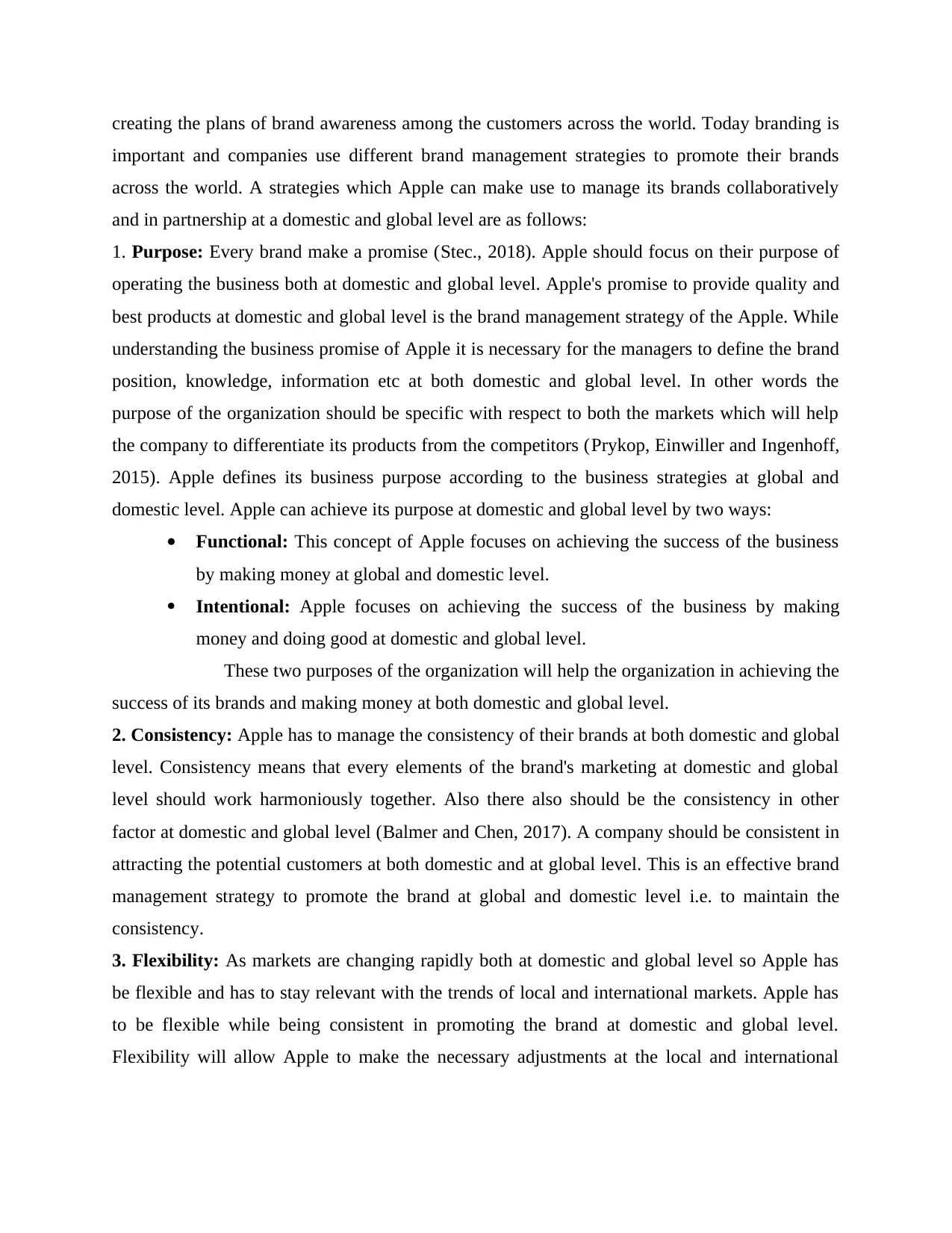
creating the plans of brand awareness among the customers across the world. Today branding is
important and companies use different brand management strategies to promote their brands
across the world. A strategies which Apple can make use to manage its brands collaboratively
and in partnership at a domestic and global level are as follows:
1. Purpose: Every brand make a promise (Stec., 2018). Apple should focus on their purpose of
operating the business both at domestic and global level. Apple's promise to provide quality and
best products at domestic and global level is the brand management strategy of the Apple. While
understanding the business promise of Apple it is necessary for the managers to define the brand
position, knowledge, information etc at both domestic and global level. In other words the
purpose of the organization should be specific with respect to both the markets which will help
the company to differentiate its products from the competitors (Prykop, Einwiller and Ingenhoff,
2015). Apple defines its business purpose according to the business strategies at global and
domestic level. Apple can achieve its purpose at domestic and global level by two ways:
Functional: This concept of Apple focuses on achieving the success of the business
by making money at global and domestic level.
Intentional: Apple focuses on achieving the success of the business by making
money and doing good at domestic and global level.
These two purposes of the organization will help the organization in achieving the
success of its brands and making money at both domestic and global level.
2. Consistency: Apple has to manage the consistency of their brands at both domestic and global
level. Consistency means that every elements of the brand's marketing at domestic and global
level should work harmoniously together. Also there also should be the consistency in other
factor at domestic and global level (Balmer and Chen, 2017). A company should be consistent in
attracting the potential customers at both domestic and at global level. This is an effective brand
management strategy to promote the brand at global and domestic level i.e. to maintain the
consistency.
3. Flexibility: As markets are changing rapidly both at domestic and global level so Apple has
be flexible and has to stay relevant with the trends of local and international markets. Apple has
to be flexible while being consistent in promoting the brand at domestic and global level.
Flexibility will allow Apple to make the necessary adjustments at the local and international
important and companies use different brand management strategies to promote their brands
across the world. A strategies which Apple can make use to manage its brands collaboratively
and in partnership at a domestic and global level are as follows:
1. Purpose: Every brand make a promise (Stec., 2018). Apple should focus on their purpose of
operating the business both at domestic and global level. Apple's promise to provide quality and
best products at domestic and global level is the brand management strategy of the Apple. While
understanding the business promise of Apple it is necessary for the managers to define the brand
position, knowledge, information etc at both domestic and global level. In other words the
purpose of the organization should be specific with respect to both the markets which will help
the company to differentiate its products from the competitors (Prykop, Einwiller and Ingenhoff,
2015). Apple defines its business purpose according to the business strategies at global and
domestic level. Apple can achieve its purpose at domestic and global level by two ways:
Functional: This concept of Apple focuses on achieving the success of the business
by making money at global and domestic level.
Intentional: Apple focuses on achieving the success of the business by making
money and doing good at domestic and global level.
These two purposes of the organization will help the organization in achieving the
success of its brands and making money at both domestic and global level.
2. Consistency: Apple has to manage the consistency of their brands at both domestic and global
level. Consistency means that every elements of the brand's marketing at domestic and global
level should work harmoniously together. Also there also should be the consistency in other
factor at domestic and global level (Balmer and Chen, 2017). A company should be consistent in
attracting the potential customers at both domestic and at global level. This is an effective brand
management strategy to promote the brand at global and domestic level i.e. to maintain the
consistency.
3. Flexibility: As markets are changing rapidly both at domestic and global level so Apple has
be flexible and has to stay relevant with the trends of local and international markets. Apple has
to be flexible while being consistent in promoting the brand at domestic and global level.
Flexibility will allow Apple to make the necessary adjustments at the local and international
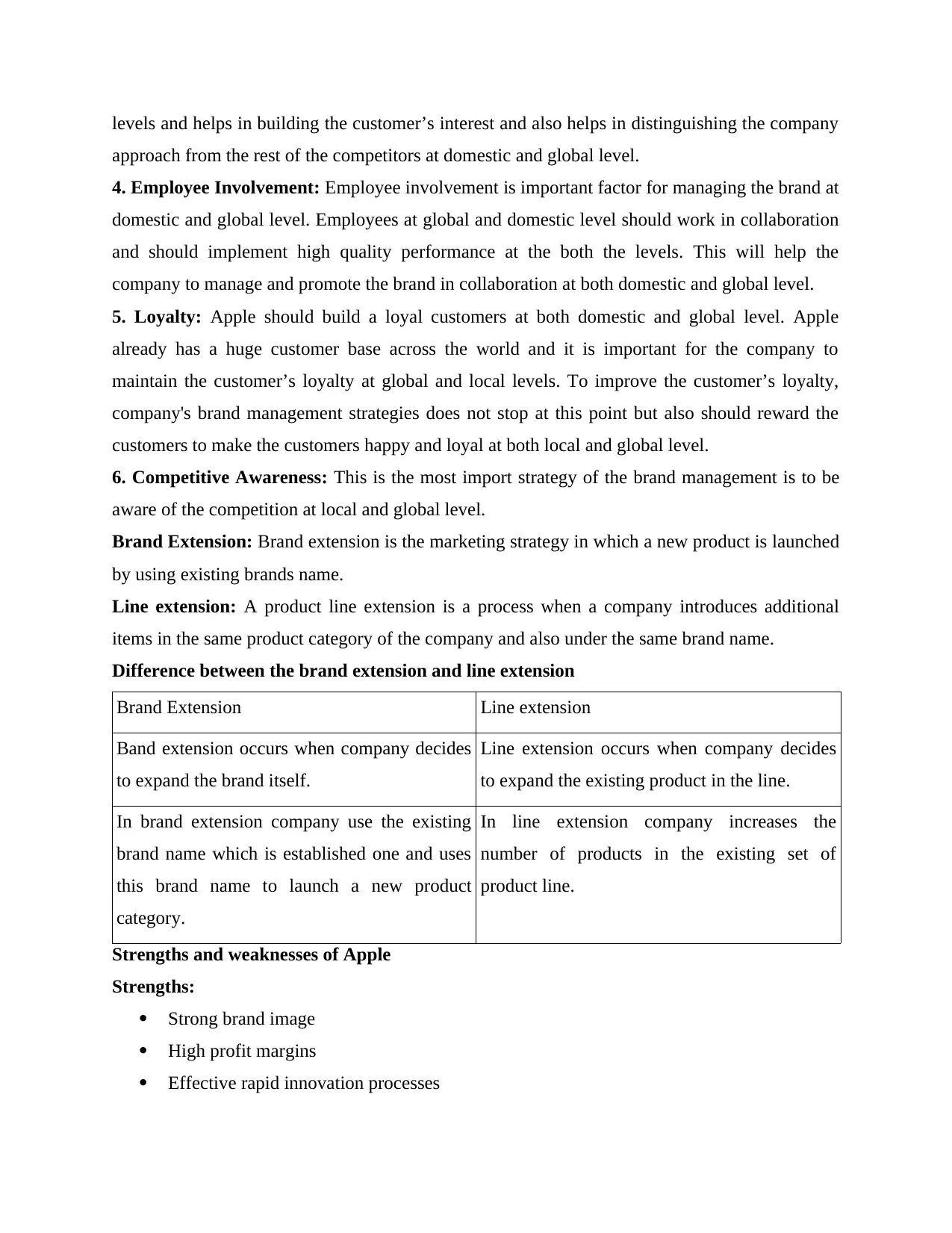
levels and helps in building the customer’s interest and also helps in distinguishing the company
approach from the rest of the competitors at domestic and global level.
4. Employee Involvement: Employee involvement is important factor for managing the brand at
domestic and global level. Employees at global and domestic level should work in collaboration
and should implement high quality performance at the both the levels. This will help the
company to manage and promote the brand in collaboration at both domestic and global level.
5. Loyalty: Apple should build a loyal customers at both domestic and global level. Apple
already has a huge customer base across the world and it is important for the company to
maintain the customer’s loyalty at global and local levels. To improve the customer’s loyalty,
company's brand management strategies does not stop at this point but also should reward the
customers to make the customers happy and loyal at both local and global level.
6. Competitive Awareness: This is the most import strategy of the brand management is to be
aware of the competition at local and global level.
Brand Extension: Brand extension is the marketing strategy in which a new product is launched
by using existing brands name.
Line extension: A product line extension is a process when a company introduces additional
items in the same product category of the company and also under the same brand name.
Difference between the brand extension and line extension
Brand Extension Line extension
Band extension occurs when company decides
to expand the brand itself.
Line extension occurs when company decides
to expand the existing product in the line.
In brand extension company use the existing
brand name which is established one and uses
this brand name to launch a new product
category.
In line extension company increases the
number of products in the existing set of
product line.
Strengths and weaknesses of Apple
Strengths:
Strong brand image
High profit margins
Effective rapid innovation processes
approach from the rest of the competitors at domestic and global level.
4. Employee Involvement: Employee involvement is important factor for managing the brand at
domestic and global level. Employees at global and domestic level should work in collaboration
and should implement high quality performance at the both the levels. This will help the
company to manage and promote the brand in collaboration at both domestic and global level.
5. Loyalty: Apple should build a loyal customers at both domestic and global level. Apple
already has a huge customer base across the world and it is important for the company to
maintain the customer’s loyalty at global and local levels. To improve the customer’s loyalty,
company's brand management strategies does not stop at this point but also should reward the
customers to make the customers happy and loyal at both local and global level.
6. Competitive Awareness: This is the most import strategy of the brand management is to be
aware of the competition at local and global level.
Brand Extension: Brand extension is the marketing strategy in which a new product is launched
by using existing brands name.
Line extension: A product line extension is a process when a company introduces additional
items in the same product category of the company and also under the same brand name.
Difference between the brand extension and line extension
Brand Extension Line extension
Band extension occurs when company decides
to expand the brand itself.
Line extension occurs when company decides
to expand the existing product in the line.
In brand extension company use the existing
brand name which is established one and uses
this brand name to launch a new product
category.
In line extension company increases the
number of products in the existing set of
product line.
Strengths and weaknesses of Apple
Strengths:
Strong brand image
High profit margins
Effective rapid innovation processes
⊘ This is a preview!⊘
Do you want full access?
Subscribe today to unlock all pages.

Trusted by 1+ million students worldwide
1 out of 17
Related Documents
Your All-in-One AI-Powered Toolkit for Academic Success.
+13062052269
info@desklib.com
Available 24*7 on WhatsApp / Email
![[object Object]](/_next/static/media/star-bottom.7253800d.svg)
Unlock your academic potential
Copyright © 2020–2025 A2Z Services. All Rights Reserved. Developed and managed by ZUCOL.





